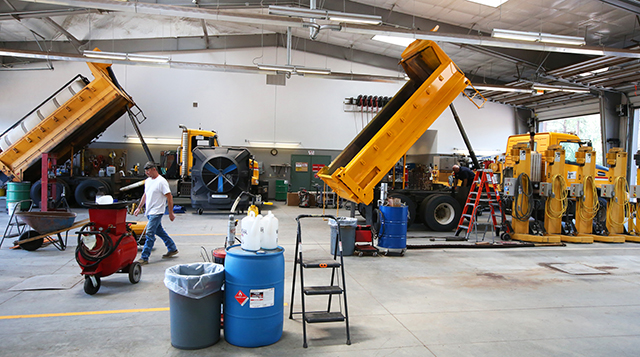Chocolate and wine pairings to try this Valentine’s Day
Published 12:00 am Tuesday, February 13, 2018

- An Aztec gold truffle from Lidia's Chocolates in Bend, made with dried poblano peppers. (Ryan Brennecke/Bulletin photo)
The tables at the end of the aisles in Newport Avenue Market often act as calendar updates as they fill up with decorations for the appropriate holiday of the month. This time heart-shaped boxes of candies, both small and large, are alongside a variety of red tones of home decor for Valentine’s Day.
On average, 50 percent of adults purchase candy for Valentine’s Day, according to the National Retail Federation. Americans also spend $8.6 million on sparkling wine, according to The Nielsen Company’s consumer and shopper insights. Chocolate and wine are two of the most popular symbols of romance.
Trending
“Chocolate is a comforting food, and we need something that makes us feel good and comforts us,” said Lidia Vazquez, owner of Lidia’s Chocolates.
“Sparkling wine is a great date wine,” said Kirk Ermisch, owner and president of Elixir Wine Group. “It has a rich history as a celebration wine and is ritualistic in its opening and toasting.”
The two have become must-haves on Valentine’s Day, but not everyone knows how to pair them together.
The abundant selection of wines at local stores can be intimidating to navigate. The Bulletin has created a list of wine and chocolate pairings for readers to try, based on recommendations by local wine shop owners, chocolatiers and a sommelier.
The pairings that have been assembled will enhance the flavor and give you something fun to discuss with your significant other.
“I would encourage you to try a pairing together, it’s more fun,” explained Madeline Puckett, a certified sommelier and the co-founder of Wine Folly. “You find out about yourself with someone else, and in a way that’s what you do when you’re on a date.”
Trending
Boutique chocolate shops
Similar to coffee and breweries, chocolate is becoming a craft commodity.
“The cool thing now with coffee, you can buy Sumatra, Peruvian, and they all have very unique different flavors,” said Ronald Smith, owner of Oregon Craft Chocolatiers in Bend.
“It’s become a craft industry that really has some big players now in it, but that is happening in the chocolate industry, like it’s on fire.”
Customers have a growing appreciation for the complexity of flavors in handmade chocolate and the nutritional benefits.
In comparison to large commercial chocolate retailers, which use preservatives and hydrogenated oils, most small-batch chocolate makers only use three to four ingredients — cacao nibs, sugar, cocoa butter and whatever the added flavoring is, such as caramel, cherry or mint.
“It’s a food source that we are just beginning to really leverage in our diets, I think,” Smith said.
Central Oregon has a surprising number of boutique chocolate shops for an area of more than 155,000 residents.
Local chocolatiers include Lidia’s Chocolates, Oregon Craft Chocolatiers, Goody’s Soda Fountain & Candy and Tricia’s True Confections.
Lidia’s Chocolates was founded by Vazquez, who has had a passion for chocolate making for several years.
“Chocolate is fascinating; it’s like a chemical reaction,” she said.
“Either you like it or you don’t like it, and it used to amaze me how well it paired with a lot of flavors.”
Vazquez uses cacao nibs from Venezuela to make her small-batch chocolates.
Some of her most popular flavors include raspberry chipotle, lemon, marionberry and Aztec gold.
The Aztec gold truffle is a combination of dark chocolate, dried poblano peppers, cumin, cloves and cinnamon.
“I’m a Hispanic, so in my culture we have mole and it’s a chocolate sauce that has lots of spices in it,” she said.
“So I wanted to come up with something unique, something that reminds me of my heritage.”
Her chocolates can be purchased at the St. Charles Hospital Gift Shop, Autry’s 4 Seasons Florist Shop or online at lidiaschocolates.com.
Both she and Smith are small-batch chocolate makers, meaning that they make a small number of chocolates at a time and the flavoring is made by hand.
When chocolates are made in smaller amounts, more attention goes into the taste of each individual chocolate.
Vazquez usually makes about 10 pounds of chocolate in each batch.
Smith makes a couple thousand chocolates over a couple of days.
“It’s a whole different experience than a Snickers bar,” Smith said.
Ronald Smith purchased the space that was formerly Pegasus Chocolate and transformed it into Oregon Craft Chocolatiers.
Inside the large chocolate shop, he has a wide assortment of flavored dark and milk chocolate truffles, including marionberry, hazelnut, jalapeño, caramel and sea salt, mint and orange. He also sells different kinds of chocolate bark such as trail bark, with nuts and dried fruit, and antioxidant bark with pumpkin seeds and nuts. Smith received a liquor license to begin selling alcohol-infused chocolates flavored with beer, whiskey and other liquors.
On a recent visit, one of his staff members was working on an Irish car bomb truffle that was filled with Jameson.
The science of taste
“I think (Champagne) is celebratory in the states, and it’s always been a sign of love and celebration, you know it’s associated with marriages, it’s associated with anniversaries, it’s associated with Valentine’s Day,” said Sarah Worley, owner of The Good Drop Wine Shoppe.
“Champagne and chocolate on Valentine’s Day, it’s like an American staple.”
Many assume pairing the correct wines and chocolates together is an easy task. After all, how can you go wrong?
But some chocolates are better at enhancing the notes in different varieties of wine than others and vice versa.
Wine and food can be paired together in two different ways, so they are congruent or complementary.
If the pairing is congruent, then the food and the wine bring out the same flavors. For example, a wine with notes of blueberry and spices might pair well with chocolate-covered blueberries.
“Wine and chocolate pairings should be of equal intensity,” Ermisch said. “You could say as a rule of thumb here, ‘like goes with like.’”
If the pairing is complementary, the food and wine have opposite flavors that, together, balance out and enhance one another.
“When you make great wine pairings, you’re basically trying to make barbecue sauce,” Puckett said. “It’s like, how can I balance sugar, fat, acid, bitterness — and alcohol is spiciness. You’re playing with this group of five fundamental tastes on your palette.”
There are a few rules of thumb to keep in mind, and there are also chocolates and wines that completely break the rules and work together.
“I think the key is to remember drier wines, more luscious chocolates, … fuller bodied wines with maybe a little drier and less sweet chocolate,” Worley said. “Just think about what tones your wine has and what’s going to go well with those tones.”
Contrary to what many people believe, “don’t pair dry red wine with chocolate,” Puckett said.
It’s important to consider the amount of sugar content in both the wine and the chocolate to avoid a combination that’s too bitter. Worley explained, “you’re not going to want to just take a dry-style cacao and a dry red because the two together are going to leave you wanting for something.”
Both chocolate and wine contain polyphenols called tannins. Tannins are filled with antioxidants, but produce a bitter, astringent quality.
“The tannins in the chocolate and the tannins in the wine clash with each other, because wine is fundamentally an acidic beverage,” Puckett said. “It makes the wine taste sour and bitter.”
— Reporter: 541-383-0351,
mcrowe@bendbulletin.com








